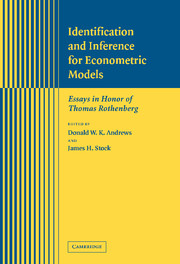Book contents
- Frontmatter
- Contents
- List of Contributors
- Preface
- Part I Identification and Efficient Estimation
- Part II Asymptotic Approximations
- 8 Asymptotic Expansions for Some Semiparametric Program Evaluation Estimators
- 9 Higher-order Improvements of the Parametric Bootstrap for Markov Processes
- 10 The Performance of Empirical Likelihood and Its Generalizations
- 11 Asymptotic Bias for GMM and GEL Estimators with Estimated Nuisance Parameters
- 12 Empirical Evidence Concerning the Finite Sample Performance of EL-type Structural Equation Estimation and Inference Methods
- 13 How Accurate is the Asymptotic Approximation to the Distribution of Realised Variance?
- 14 Testing the Semiparametric Box–Cox Model with the Bootstrap
- Part III Inference Involving Potentially Nonstationary Time Series
- Part IV Nonparametric and Semiparametric Inference
11 - Asymptotic Bias for GMM and GEL Estimators with Estimated Nuisance Parameters
Published online by Cambridge University Press: 24 February 2010
- Frontmatter
- Contents
- List of Contributors
- Preface
- Part I Identification and Efficient Estimation
- Part II Asymptotic Approximations
- 8 Asymptotic Expansions for Some Semiparametric Program Evaluation Estimators
- 9 Higher-order Improvements of the Parametric Bootstrap for Markov Processes
- 10 The Performance of Empirical Likelihood and Its Generalizations
- 11 Asymptotic Bias for GMM and GEL Estimators with Estimated Nuisance Parameters
- 12 Empirical Evidence Concerning the Finite Sample Performance of EL-type Structural Equation Estimation and Inference Methods
- 13 How Accurate is the Asymptotic Approximation to the Distribution of Realised Variance?
- 14 Testing the Semiparametric Box–Cox Model with the Bootstrap
- Part III Inference Involving Potentially Nonstationary Time Series
- Part IV Nonparametric and Semiparametric Inference
Summary
ABSTRACT
This chapter studies and compares the asymptotic bias of GMM and generalized empirical likelihood (GEL) estimators in the presence of estimated nuisance parameters. We consider cases in which the nuisance parameter is estimated from independent and identical samples. A simulation experiment is conducted for covariance structure models. Empirical likelihood offers much reduced mean and median bias, root mean squared error and mean absolute error, as compared with two-step GMM and other GEL methods. Both analytical and bootstrap bias-adjusted two-step GMM estimators are compared. Analytical bias-adjustment appears to be a serious competitor to bootstrap methods in terms of finite sample bias, root mean squared error, and mean absolute error. Finite sample variance seems to be little affected.
INTRODUCTION
It is now widely recognized that the most commonly used efficient two-step GMM (Hansen, 1982) estimator may have large biases for the sample sizes typically encountered in applications. (See, for example, the Special Section, July 1996, of the Journal of Business and Economic Statistics). To improve the small sample properties of GMM, a number of alternative estimators have been suggested, which include empirical likelihood (EL) (Owen 1988, Qin and Lawless 1994, Imbens 1997), continuous updating (CUE) (Hansen, Heaton, and Yaron 1996), and exponential tilting (ET) (Kitamura and Stutzer 1997, Imbens, Spady, and Johnson 1998).
- Type
- Chapter
- Information
- Identification and Inference for Econometric ModelsEssays in Honor of Thomas Rothenberg, pp. 245 - 281Publisher: Cambridge University PressPrint publication year: 2005
- 4
- Cited by

